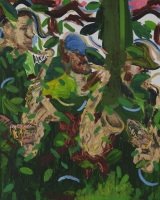鄭皓中擅長人物肖像繪畫,他常以身邊親近的人作為繪畫對象,從他人的身上尋找「自我」表現的線索。畫室既是他工作的空間,亦是他創作的靈感來源之一。他繪畫的畫面中經常以畫室為背景,畫室墻上的窗戶分隔了畫室的內部和外部,隱喻著他連接世界的出入口。在疫情期間,鄭氏持續練習薩克斯風,音樂的表演性質也逐漸融入了他的繪畫語言。儘管都是人物肖像的題材,但不同的人物對象傳遞出了截然不同的心理狀態和情緒。友人的肖像著重於親密關係中的微妙距離,自我的描繪則用到音樂般的表演性來探索孤獨的語境。在鄭皓中的繪畫中可以看到,表演性如何遊走於具象描摹和抽象線條之中,進行筆勢和筆勢之間的交流。一如長音和短音、和弦與變調,他的繪畫不斷地在規範的制式邊緣遊走,以期演繹一種在動態秩序下的不和諧音。
《邱晨在畫室嗎?》中描繪的人物名叫邱晨。作為鄭皓中的好友,邱晨常常作為模特出現在他的作品中。畫面中的邱晨閉目養神,坐在藝術家畫室的綠色椅子上。他的頭被黑色線條圍成的籠子所包圍,似乎被困於其中,思緒也被抑於心中。 “籠子”這一元素的出現使人聯想到比利時超現實主義藝術家René Magritte的代表作《Therapeuist》(1937)和《The Great War》(1964)。在Magritte的作品中,籠子象徵著精神分析與禁錮束縛。
畫面中的另一元素“蘋果”則致敬了油畫大師Paul Cézanne。Cézanne常常通過描繪蘋果等日常靜物,表達對於短暫的生命的思考。 鄭皓中在該幅畫作中描繪了一個成熟的蘋果與一個腐爛的蘋果,強調了生命的無常,以及人與人之間瞬息萬變的聯繫。
《紋樣、金色、LIXINYANG》中描繪的人物是藝術家的親密伴侶。在這幅肖像畫中,一名年輕的女子側身而立,雙手背在身後,目光凝視前方。畫面色彩淡麗,籠罩著一層柔和的女性氣質。金色筆觸的點綴為畫面增添了空間感,使其更富有生命力。午後柔和的陽光灑落在地面上,如同微風吹過水面泛起漣漪。
《她的四次描繪以及旋律號角》對同一女性形象的不同角度進行側寫,畫面中心的三角形破除了人物的重複性,短促的藍色筆觸畫上“否定”符號,亮眼的金色的點綴散落在畫面空白處,一切都在動態中逐漸趨於穩定。
《紋樣、紅色、AG》畫面中心身著鮮紅色連衣裙的女性引人注目,她的連身裙、頭髮、身體姿態,甚至作為背景的畫作和地板,都以流溢的曲線所勾勒。
《唐潮與綠椅子》的主人公唐潮是一位影像藝術家,也是鄭皓中的藝術夥伴。畫面中的唐潮頭戴藍色帽子,衣
着寬鬆,面無表情地斜靠在鄭皓中畫室的椅子上。藝術家以簡潔的線條勾勒出人物輪廓,刻意忽略了部分細節。細節的忽略和綠色椅背的襯托,使得人物的面部表情顯得尤為突出,捕捉到其內心的光景和獨特的氛圍。
Zheng Haozhong creates portrait paintings of close friends andacquaintances, finding traces of self-expression in the depictionof other individuals. His studio acts as a working space but also asource of inspiration, often serving as a backdrop in his paintings. The window on the studio wall emphasizes the interiority of the space,analogous to his connection to the exterior world. His work is imbued with an expressive and uninhibited character, reminiscent of musical improvisation. The brushstrokes channel the sentiments of his sitters,and teetering on prescribed norms, they are like discordant notes within order.
The self-portrait unveils the inner psyche of the artist as he peers through the window panes,seemingly in deep contemplation.Zheng’s paintings convey the distinctive expressions and gestures of each sitter, these portrayals of friends and companions hint at the subtle and unspoken distance within relationships. They embody an expressiveness that treads the line between figurative depiction and abstract representations, each brushstroke an extension of the artist’s performance.Paralleling long and short tones, chords and modulations, his paintings straddle the boundaries of prescribed norms, performing dissonant notes within a dynamic framework.
QIUCHEN in the Studio? portrays Qiuchen, a figure frequently seen in Zheng Haozhong’s paintings. The subject is depicted in a relaxed pose with his eyes closed, sitting back in a green chair in the artist’s studio. His head is trapped in a cage, and his mind trapped in his inner thoughts. The use of the cage as a motif harkens back to the iconic works by Belgian surrealist artists Rene Magritte’s works, particularly Therapeuist (1937) or The Great War (1964), which serves as a powerful symbol of psychoanalysis and imprisonment.
The presence of apples in Zheng’s works pay homage to Cézanne’s works, and his contemplation of the transience of life. Through the depiction of ripe and decaying apples,Zheng highlights the impermanence of life and the fleeting nature of human connections.
Patterns, Gold, LIXINYANG is an intimate portrayal of the artist’s partner. The portrait portrays the profile of the young woman, she stares afar with her arms crossed behind her back. The light colors of the canvas evoke an air of softness and feminine touch. The portrait comes alive with dashes of gold brush strokes, creating a sense of spatial depth. A gentle ray of afternoon sunshine bathes the foreground, unfurling like a shimmering ripple on the ocean water.
Four Portrayals of Her and the Melody Horns depicts the same young woman from different angles. A triangle occupies the picture plane hence disrupting the repetition of the female sitter and adding dynamism to the composition. Dashes of blue brushstrokes and dots of gold, freestyle and imbued with momentum, are scattered across the blank canvas.
Few of the strokes have been crossed out by the artist as an afterthought, laying bare his thinking process.
In Patterns, Red, AG, a woman is seated in a striking red dress. Her dress, let-down hair, body posture, the floor, and the paintings hanging behind her are delineated by thick undulating lines, captivating the viewer from afar.
TANGCHAO and the Green Chair features Tang Chao, a video artist and artistic companion of Zheng.
Adorned in a blue hat and loose attire, the subject carries a deadpan expression, sluggishly reclining into a studio chair. The artist delineates the contours of the subject’s body, deliberately omitting certain details of the figure. The intentional absence of paint and other information accentuates the subject’s facial expression against the emerald green chair back, capturing his psyche and unique aura.







